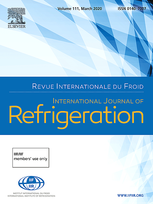
Summary
The spring system is the key component of linear compressor, which is attractive in the field of household refrigeration due to its high efficiency and compact structure. Inspired by the traditional flexure spring, we proposed a novel cylindrical arm spiral spring for linear compressor with a comprehensive consideration on the cost, compactness and performance requirements. The design method of spring was introduced and different performance can be obtained by adjusting the internal radius, external radius, number of turns and wire diameter. The static displacement of spring was modelled by using FEA (Finite Element Analysis) method for various axial and radial force. And a specific fixture was built to measure the spring stiffness to verify the results obtained from FEA simulation. At last, the dynamic test of the linear compressor equipped with the proposed spring was conducted. The experimental results showed that the resonant frequency of linear compressor can meet the design requirements of 78 Hz without gas compressor, indicating that the application of this type of spring in the linear compressor is feasible.
Available documents
Format PDF
Pages: 1000-1009
Available
Public price
20 €
Member price*
Free
* Best rate depending on membership category (see the detailed benefits of individual and corporate memberships).
Details
- Original title: Characteristics of a novel cylindrical arm spiral spring for linear compressor.
- Record ID : 30029205
- Languages: English
- Subject: Technology
- Source: International Journal of Refrigeration - Revue Internationale du Froid - vol. 131
- Publication date: 2021/11
- DOI: http://dx.doi.org/10.1016/j.ijrefrig.2021.07.006
- Document available for consultation in the library of the IIR headquarters only.
Links
See other articles in this issue (95)
See the source
Indexing
-
Development of a new moving magnet linear compr...
- Author(s) : BIJANZAD A., HASSAN A., LAZOGLU I., KERPICCI H.
- Date : 2020/05
- Languages : English
- Source: International Journal of Refrigeration - Revue Internationale du Froid - vol. 113
- Formats : PDF
View record
-
A sensor-less stroke detection technique for li...
- Author(s) : JIANG H., LIANG K., LI Z., ZHU Z., ZHI X., QIU L.
- Date : 2020/06
- Languages : English
- Source: International Journal of Refrigeration - Revue Internationale du Froid - vol. 114
- Formats : PDF
View record
-
A review of linear compressors for refrigeration.
- Author(s) : LIANG K.
- Date : 2017/12
- Languages : English
- Source: International Journal of Refrigeration - Revue Internationale du Froid - vol. 84
- Formats : PDF
View record
-
Thermo-economical sensitivity analysis of a lin...
- Author(s) : MASTRULLO R., MAURO A. W., NAPOLI G., VISCITO L.
- Date : 2022/10
- Languages : English
- Source: International Journal of Refrigeration - Revue Internationale du Froid - vol. 142
- Formats : PDF
View record
-
Thermodynamic analysis of linear compressor usi...
- Author(s) : LI Z., LIANG K., JIANG H.
- Date : 2019/08
- Languages : English
- Source: International Journal of Refrigeration - Revue Internationale du Froid - vol. 104
- Formats : PDF
View record
